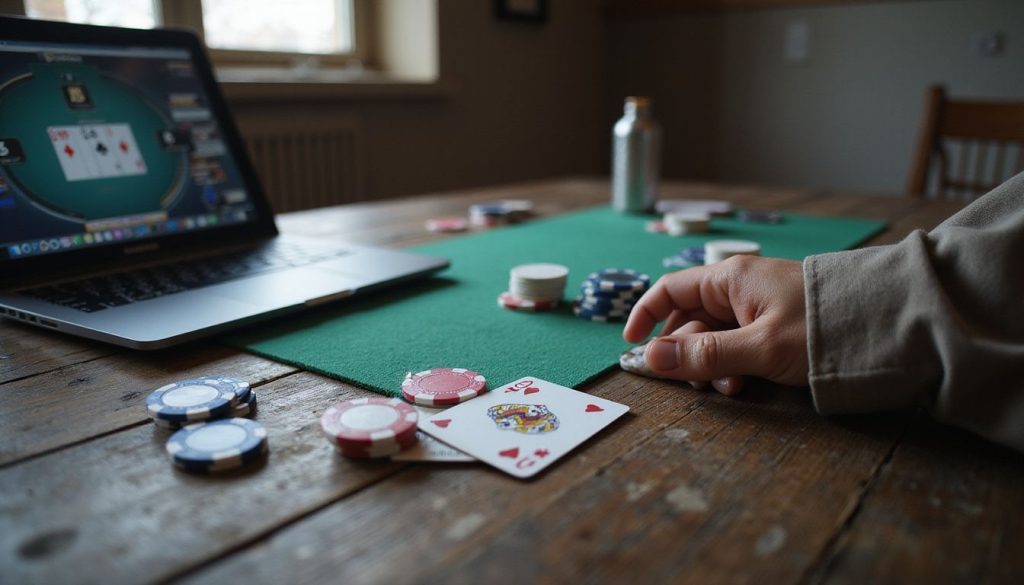Making ICM mistakes in Sit and Go tournaments can crush your poker profits faster than a bad beat. Many players struggle with Independent Chip Model (ICM) decisions, especially when the money bubble approaches.
I’ve seen countless players blow their tournament lives by ignoring ICM principles at crucial moments.
ICM helps you convert your tournament chips into real money equity. This vital concept changes how you should play hands compared to regular cash games. Your chip stack size, position, and the payout structure all affect your ICM decisions.
Without proper ICM understanding, you’ll make costly mistakes that hurt your Return on Investment (ROI).
I’ll show you the five biggest ICM mistakes that plague Sit and Go players. You’ll learn how to spot these errors and fix them before they damage your bankroll. Plus, you’ll discover practical tips to sharpen your ICM strategy near the bubble.
Ready to boost your Sit and Go profits?
Mistake 1: Ignoring ICM and Playing for Chip EV

Many players jump straight into tournament play without grasping ICM principles. The Independent Chip Model shows how tournament chips convert to real money equity. Players often focus too much on chip expected value (EV) instead of ICM considerations, leading to costly mistakes.
ICM isn’t an exact science, but ignoring it will cost you money. – Nick Petrangelo
The biggest blunder comes from treating tournament chips like cash game chips. Players need to adjust their ranges based on stack sizes and pay jumps. A classic example happens on the bubble, where big stacks often play too loose from the button.
The right move involves tightening up and letting shorter stacks battle it out. Smart players use ICM calculators to study spots and compare them to chip EV situations. This helps create better decision-making patterns for future games.
Mistake 2: Misjudging the Importance of Pay Jumps
Pay jumps in Sit and Go tournaments can make or break your poker profits. Players often focus too much on chip accumulation without considering the real money value of their stack.
Smart players know that a 20,000-chip stack near the bubble holds different values based on payout structures. Nick Petrangelo points out that treating ICM as pure math misses crucial strategic elements.
Your decisions must shift as prize differences between positions grow larger. The Independent Chip Model shows how tournament chips convert to actual cash equity. This knowledge helps you avoid costly mistakes in crucial moments.
Stack awareness becomes vital as you approach significant pay jumps. A big stack with 50 big blinds might need to fold premium hands against a short stack shoving with 10 big blinds.
The ROI impact of these decisions grows exponentially near the money bubble. ICM calculators prove that calling too wide in these spots destroys tournament equity. Players must adjust their ranges based on stack sizes and prize pool distribution.
Tight play in early stages builds a foundation for proper ICM decisions later. Your skill edge matters less if you misplay these high-pressure situations. Short stacks gain leverage against bigger stacks during key pay jump moments.
Mistake 3: Failing to Account for Other Stacks at the Table
Players often focus too much on their own stack size in Sit and Go tournaments. Smart players watch every stack at the table like a hawk. Your decisions must change based on the short stacks and big stacks around you.
Nick Petrangelo points out that treating ICM as pure math misses crucial dynamics. A medium stack should play differently against two short stacks versus two big stacks.
Stack awareness impacts your fold equity and betting choices. The Independent Chip Model shows how chips convert to real money equity. A player with 30 big blinds might need to fold QQ preflop if caught between a short stack shoving and a big stack behind.
Your position relative to other stacks affects optimal play on the bubble. Short stacks create pressure while big stacks threaten your tournament life. Moving on to another critical ICM mistake, many players struggle with overvaluing premium hands in key spots.
Mistake 4: Overvaluing Strong Hands in ICM Situations
Stack sizes matter greatly in tournament play, but strong hands can trick you into making costly ICM mistakes. Many poker players fall into the trap of overvaluing premium hands like pocket aces during crucial ICM spots.
Nick Petrangelo points out that ICM isn’t an exact science, and holding big pairs doesn’t automatically justify calling all-in bets. Your tournament chips convert to real money equity differently based on pay jumps and stack distributions.
Big hands feel great to play, but they can lead to disaster near the money bubble. A classic example happens in Sit and Go tournaments where short stacks push all-in against big stacks.
The chip leader might hold kings or queens but should still fold because the ICM pressure from smaller stacks makes calling too risky. The math shows that protecting your stack often brings more value than trying to eliminate players with premium holdings.
Smart players use ICM calculators to study these spots and adjust their ranges accordingly. This helps avoid the common trap of playing too many hands, especially during the early stages where tight play works best.
Mistake 5: Not Adjusting to Opponents’ ICM Mistakes
Strong hands in ICM situations require careful play, but spotting your opponents’ ICM mistakes opens up huge profit opportunities. Many players fail to adapt their strategy based on how their opponents misplay ICM spots.
Your rivals might stick to basic chip EV plays without considering the tournament payout structure. This creates perfect chances for you to exploit their mistakes and boost your ROI.
Nick Petrangelo points out that players often treat ICM too rigidly, missing chances to capitalize on others’ errors.
Smart players look for specific ICM leaks in their opponents’ games. Some rivals call too loose as blinds increase, while others play too many hands in early stages. You can profit by identifying these patterns and adjusting your ranges accordingly.
The key lies in staying flexible with your strategy, especially near the money bubble. Tight players might fold too much to your aggression, giving you free chips. Big stacks often bully small stacks without proper ICM consideration, creating perfect spots for you to fight back with the right hands.
Your skill edge grows larger as you spot and exploit these common ICM mistakes at the table.
How to Avoid Common ICM Mistakes
Let me show you some proven tools and methods to dodge those pesky ICM mistakes that cost you money in Sit and Go tournaments.
Use ICM Calculators and Tools
ICM calculators serve as vital tools for poker players who want to boost their tournament results. These digital aids help players convert their tournament chips into real money equity, making tough decisions easier at the table.
Top players like Nick Petrangelo rely on ICM tools and advanced HUD software to study postflop situations and compare them with Chip EV scenarios. The right calculator shows you exactly how much your stack is worth in actual dollars at any point in the tournament.
Modern ICM tools go beyond basic calculations to help players fine-tune their decision-making process. They offer quick insights about pay jumps, stack sizes, and optimal calling ranges during crucial moments.
Players can plug in different stack sizes and payout structures to practice ICM-based decisions before facing them in real games. This hands-on practice builds confidence and reduces costly mistakes, especially near the money bubble or final table where every choice matters most.
Practice Adjusting Ranges Based on ICM
Beyond using tools, you must practice adjusting your poker ranges based on stack sizes and positions. Your opening ranges need constant fine-tuning as the tournament progresses, especially near the bubble.
Nick Petrangelo stresses that ICM isn’t an exact science, so practical experience matters more than pure calculations.
Live practice helps you master the balance between chip EV and real money equity. Start by playing tight in early stages, then adjust your ranges as blinds increase. Big stacks can open wider, while short stacks must focus on survival spots.
Pay close attention to pay jumps and stack sizes of other players at your table. This hands-on approach builds better instincts for future game situations.
Importance of Stack Awareness in ICM Play
Stack awareness shapes your ICM decisions at every stage of a Sit and Go tournament. Your chip stack directly affects your real money equity, making each decision crucial for tournament survival.
Smart players track all stack sizes at the table to make better ICM choices. Nick Petrangelo stresses that ICM isn’t an exact science, but understanding stack dynamics helps maximize your ROI.
Big stacks must avoid playing too loose from the button, while short stacks need precise fold equity calculations. Your position and stack size influence your calling ranges as blinds increase.
ICM calculators help measure these stack-based decisions against pure chip EV spots. Players who master stack awareness spot profitable situations near the money bubble. Let’s explore how to adjust your strategy as you approach crucial pay jumps.
Adapting Your Strategy Near the Bubble
The bubble phase demands sharp adjustments to your standard gameplay. Your chip stack directly affects your real money equity during this crucial period. Big stacks should apply pressure through aggressive plays, while short stacks need to tighten up their ranges.
Nick Petrangelo points out that ICM shouldn’t control every decision, but it must guide your overall strategy near the money bubble.
Players must shift their focus from pure chip EV to tournament equity considerations. A tight style works best for most players during the bubble, especially as blind levels increase.
The Independent Chip Model shows that calling becomes less profitable in these spots. Smart players look for spots to leverage fold equity against medium stacks who can’t risk elimination.
This approach helps maximize ROI while maintaining tournament survival chances.
Leveraging ICM to Maximize Tournament Results
Smart players boost their tournament profits by mastering Independent Chip Model (ICM) principles. Nick Petrangelo points out that ICM works as a guide rather than an exact formula.
Players need to adapt their chip stack decisions based on payout structures and table dynamics. Converting tournament chips into real money equity helps make better choices near pay jumps.
ICM calculations shine brightest during crucial moments in Sit and Go tournaments. Big stacks must avoid needless risks against short stacks, especially close to the money bubble. Skilled players adjust their ranges earlier in tournaments instead of waiting for the bubble.
Using ICM calculators helps develop solid decision-making skills for different stack sizes. Players who stick to tight play early and loosen up at the right spots see higher ROI in their games.
Tips for Continuous Improvement in ICM Strategy
ICM mastery demands constant practice and dedication to improve your tournament results. Let’s explore proven tips to sharpen your ICM skills and boost your poker profits.
- Study ICM calculators daily for 30 minutes to understand chip value conversions in different stack sizes.
- Record your tournament hands and review them against ICM calculations to spot missed opportunities.
- Practice making ICM-based decisions at different stack depths before reaching the bubble.
- Run simulations of final table scenarios using future game simulation tools to test your strategy.
- Track your results in different stack positions to identify patterns in your ICM decision-making.
- Join study groups focused on ICM strategy to share insights and learn from others’ experiences.
- Start each session with clear stack-based goals aligned with proper ICM play.
- Compare your decisions to GTO solutions in similar spots to find leaks in your game.
- Focus on pay jump awareness during live play rather than just chip accumulation.
- Learn to spot opponents who ignore ICM principles and adjust your strategy accordingly.
- Build a database of common ICM spots from your games for later review.
- Practice adjusting your ranges based on stack sizes and positions at the table.
- Study postflop ICM spots against different stack sizes to improve decision-making.
- Follow Nick Petrangelo’s advice about treating ICM as a flexible guide rather than exact science.
- Create specific action plans for different blind levels and stack depths.
Conclusion
Mastering ICM strategy takes time and practice. Smart players dodge costly mistakes by studying pay jumps and stack sizes. Your tournament success depends on making the right calls near the bubble.
Tools like ICM calculators help you make better decisions at crucial moments. Take action today by practicing these concepts in low-stakes games before moving up to bigger tournaments.
FAQs
1. What is ICM in poker tournaments?
ICM (Independent Chip Model) calculates your chips’ real money value in poker tournaments. It helps players make better decisions by showing how chip stacks relate to prize money, especially during money bubble situations.
2. Why does ICM matter in Sit and Go formats?
ICM shapes your strategy because chip values change based on the payout structure. Your decisions must account for both chip EV and tournament ROI, not just standard poker odds.
3. How does ICM affect play on the final table bubble?
Players with big stacks should avoid marginal spots against short stacks. The risk of busting outweighs the potential chip gains because ICM pressure makes each chip worth more in terms of actual money.
4. Should I use different ICM strategies in PKO tournaments?
PKO tournaments need a modified ICM approach since bounties change the math. Your skill edge matters more in PKO formats than regular Sit and Go tournaments.
5. When should I ignore ICM calculations?
During heads-up play, ICM becomes less important. Focus more on GTO principles and fold equity when you’re down to the final two players.
6. How do blind levels impact ICM decisions?
Rising blind levels force short stacks to make moves, creating ICM pressure. Smart players use ICM calculators to find spots where others make mathematical mistakes due to changing stack depths.








